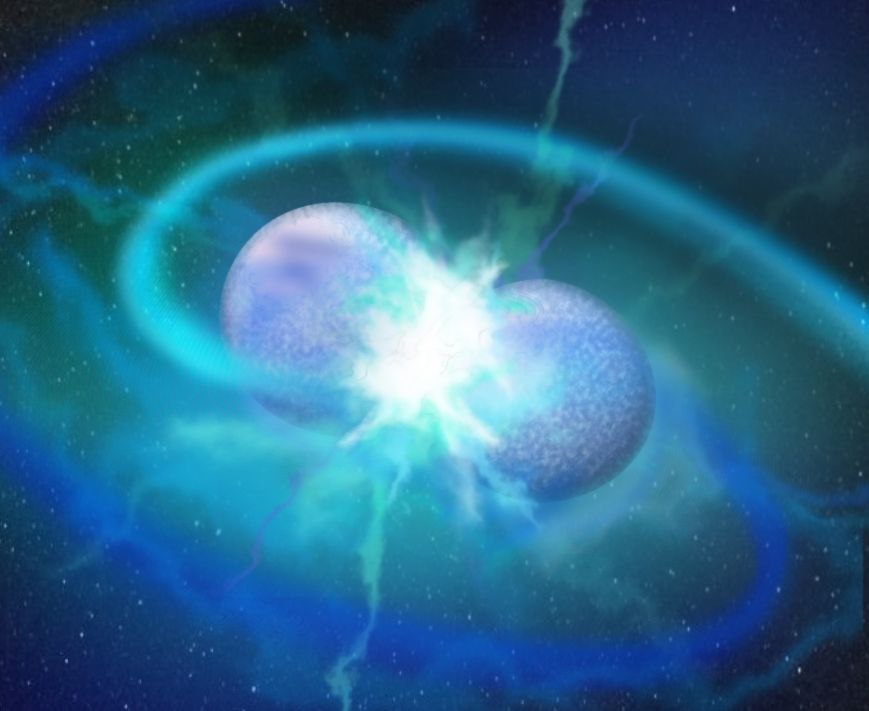Press Releases
14.02.2022
Astronomers observe a rare stellar wedding
Research team from the University of Tübingen encounters new type of star with unusual properties - possibly two white dwarfs which have merged
Astronomers from the Universities of Tübingen and Potsdam have discovered a new type of star. While hunting for "hot stars" with the Large Binocular Telescope in Arizona, the team came across stars with unusual properties. While normal stellar surfaces are composed of hydrogen and helium, these stars, found under the direction of Professor Klaus Werner of the University of Tübingen, are covered in carbon and oxygen - the ash of a helium nuclear fusion. The exotic composition is all the more puzzling because the temperatures and diameters of the stars indicate that helium nuclei continue to fuse inside them. The results have been published in the Monthly Notices of the Royal Astronomical Society.
The typical life cycle of a star like our Sun begins with the nuclear fusion of hydrogen into helium. Then, deep inside the star, a nuclear reaction begins that converts helium into carbon and oxygen. The star "dies" in the course of millions of years and shrinks to a “white dwarf”.
"We normally expect stars with the chemical surface composition of the stars discovered to have completed the helium fusion in their centers and to be in the final stages of becoming white dwarfs," explains Klaus Werner of the Institute for Astronomy and Astrophysics. It is known that there are objects covered with carbon and oxygen instead of hydrogen. The cause is thought to be an explosive resumption of helium fusion, which then brings the burning ash - carbon and oxygen - to the surface. "However, this event cannot explain these newly discovered stars. They have larger radii and carry out helium fusion peacefully at their centers."
A possible explanation for the formation of these atypical stars is provided by a parallel paper published by astronomers at the University of La Plata (Argentina), led by Marcelo Miller Bertolami. "We believe that the stars discovered by our German colleagues were formed by a very rare type of merging between two white dwarfs," says Miller Bertolami, first author of the companion paper.
The merger of white dwarfs in close binary star systems can occur because the distance between their orbits is constantly decreasing due to the emission of gravitational waves. "This does not normally lead to the formation of a star enriched in carbon and oxygen," explains Nicole Reindl of the University of Potsdam. "However, we believe that in binary systems with very specific stellar masses, a white dwarf with a carbon-oxygen core can be ripped apart by tidal forces. Its material is then dumped on the surface of its white dwarf companion, leading to the formation of these exotic stars." However, more detailed evolutionary models are needed to fully explain the phenomenon.
The stars were found as part of a large-scale search program in which researchers are tracking down short-lived, hot stars to better understand the final stages of stellar evolution. This involves collecting and analyzing the stars' spectra, for example, to determine their chemical composition. Because these stars have low luminosity, this requires large optical telescopes. The largest, which contributed to the new discovery, is the Large Binocular Telescope in Arizona, consisting of two large primary mirrors, each 8.4 meters in diameter.
Publications:
Klaus Werner, Nicole Reindl, Stephan Geier, Max Pritzkuleit: Discovery of hot subdwarfs covered with helium-burning ash. Monthly Notices of the Royal Astronomical Society, https://academic.oup.com/mnrasl/article-lookup/doi/10.1093/mnrasl/slac005
Marcelo M. Miller Bertolami, Tiara Battich, Alejandro H. Córsico, Leandro G. Althaus, Felipe C. Wachlin: An evolutionary channel for CO-rich and pulsating He-rich subdwarfs. Monthly Notices of the Royal Astronomical Society, https://academic.oup.com/mnrasl/article-lookup/doi/10.1093/mnrasl/slab134
Contact:
Prof. Dr. Klaus Werner
University of Tübingen
Department of Physics
Institute of Astronomy and Astrophysics
+49 7071 29-78601
wernerspam prevention@astro.uni-tuebingen.de
Contact for press:
Eberhard Karls Universität Tübingen
Public Relations Department
Dr. Karl Guido Rijkhoek
Director
Antje Karbe
Press Officer
Phone +49 7071 29-76789
Fax +49 7071 29-5566
antje.karbespam prevention@uni-tuebingen.de
www.uni-tuebingen.de/en/university/news-and-publications

